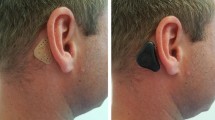Abstract
Objective
The ADHEAR system (MED-EL, Innsbruck, Austria) is a new adhesive bone conduction hearing aid. This study evaluates the audiological benefit and subjective satisfaction as well as the manageability in everyday life in children with unilateral conductive hearing loss.
Methods
Ten children with unilateral hearing loss of different origin were included in the study. The audiological assessment included sound field audiometry and speech intelligibility in quiet and in noise, which was tested unaided and after 4 weeks of wearing the hearing system. Subjective benefit and satisfaction with the system was assessed using the SSQ for parents. With a second system-specific questionnaire, suitability for everyday use and quality of life were queried.
Results
With ADHEAR, speech perception in quiet improved by 44%. The word recognition score in noise improved from 11.7% in the unaided situation to 46.7% with the ADHEAR system. The SSQ for parents demonstrates a subjective benefit and satisfaction with the system.
Conclusion
ADHEAR is an effective treatment option for children with unilateral conductive hearing loss. Especially children who are not eligible for semi-implantable hearing systems or do not accept hearing devices on a softband can benefit from this device.







Similar content being viewed by others
References
Hakansson B et al (1985) The bone-anchored hearing aid. Principal design and a psychoacoustical evaluation. Acta Otolaryngol 100(3):229–239
Zarowski AJ et al (2011) Headbands, testbands and softbands in preoperative testing and application of bone-anchored devices in adults and children. AdvOtorhinolaryngol 71:124–131
Reinfeldt S et al (2015) New developments in bone-conduction hearing implants: a review. Med Devices (Auckl) 8:79–93
Dahm V et al (2019) A Randomized cross-over trial comparing a pressure-free, adhesive to a conventional bone conduction hearing device. OtolNeurotol 40(5):571–577
Hahlbrock K-H (1953) ÜberSprachaudiometrie und neueWörterteste. ArchivfürOhrenNasenKehlkopfheilkunde 162:394–431
Weissgerber T et al (2012) German Oldenburg Sentence Test for Children: a useful speech audiometry tool for hearing-impaired children at kindergarten and school age. Folia PhoniatrLogop 64(5):227–233
Noble W et al (2013) A short form of the speech, spatial and qualities of hearing scale suitable for clinical use: the SSQ12. Int J Audiol 52(6):409–412
Verhagen CV et al (2008) The Baha Softband. A new treatment for young children with bilateral congenital aural atresia. Int J PediatrOtorhinolaryngol 72(10):1455–1459
Neumann K et al (2019) A new adhesive bone conduction hearing system effectively treats conductive hearing loss in children. Int J PediatrOtorhinolaryngol 122:117–125
Osborne MS et al (2019) First pediatric experience with a novel, adhesive adapter retained, bone conduction hearing aid system. OtolNeurotol 40(9):1199–1207
Zernotti M (2019) The adhesive bone conduction hearing system in children with Atresia and Microtia, in ESPCI 2019. Bucharest, Romania
Gavilan J (2019) Comparison of the non-invasive adhesive bone conduction system with passive transcutaneous bone conduction implants in children, in EPSCI2019. Bucharest, Romania
Weiss R et al (2020) A new adhesive bone conduction hearing system as a treatment option for transient hearing loss after middle ear surgery. Eur Arch Otorhinolaryngol 277(3):751–759
Gawliczek T et al (2018) Unilateral and bilateral audiological benefit with an adhesively attached, noninvasive bone conduction hearing system. OtolNeurotol 39(8):1025–1030
Dahm V et al (2018) First results with a new, pressure-free, adhesive bone conduction hearing aid. OtolNeurotol 39(6):748–754
Author information
Authors and Affiliations
Corresponding author
Ethics declarations
Conflict of interest
The author Daniel Hirth and Roxanne Weiss received a financial support for attending the symposium “Deutscher HNO-Kongress” 2019 in Berlin. The other authors declare that they have no conflict of interest.
Human and/or animals rights
All procedures performed in this study involving human participants were in accordance with the ethical standards by the ethics committee of the medical faculty Frankfurt (EC code 92/17) and with the 1964 Helsinki Declaration and its later amendments or comparable ethical standards. This article does not contain any studies with animals performed by any of the authors.
Informed consent
Informed consent was obtained from all participants included in the study.
Additional information
Publisher's Note
Springer Nature remains neutral with regard to jurisdictional claims in published maps and institutional affiliations.
Rights and permissions
About this article
Cite this article
Hirth, D., Weiss, R., Stöver, T. et al. Audiological benefit and subjective satisfaction with the ADHEAR hearing system in children with unilateral conductive hearing loss. Eur Arch Otorhinolaryngol 278, 2781–2788 (2021). https://doi.org/10.1007/s00405-020-06364-2
Received:
Accepted:
Published:
Issue Date:
DOI: https://doi.org/10.1007/s00405-020-06364-2




